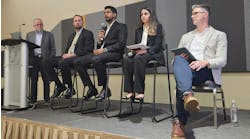The directional properties of LEDs and their affinity for cool climates have allowed the technology to expand into a wide spectrum of applications, from parking lots to indoor uses.
Not all applications are completely LED-ready, but there are several instances where you can reap considerable energy and cost savings from the reduced maintenance requirements and energy-efficient function.
“Traffic signals are a perfect example. There certainly is energy savings, but the payback comes through maintenance, not having to get a guy out in the intersection in a cherry picker and shut the street down,” explains Ron Steen, vice president of business development for solid state lighting developer Xicato.
When to Reconsider
Despite their rapid growth in popularity, LEDs aren’t always the answer for some applications. HID, which still boasts high efficiency, is frequently the best choice for roadway lighting and very high ceilings that require large amounts of light, says Jeff Spencer, director of commercial product management for Juno Lighting Group by Schneider Electric.
Induction lighting is another ultra-efficient option, though their lifespan (frequently rated around twice that of a comparable LED fixture) is balanced out by a price tag that’s cost-prohibitive for many budgets.
“There are also some applications where the designer is looking for the ambiance they can get from the warm glow of a dimmed incandescent,” Spencer explains. “They like that the incandescent lamps get warmer when they dim, as opposed to staying the same color temperature with less light like LEDs.”
Retrofit projects may also pose a problem, depending on what type of fixture you’re trying to fit LEDs into.
“LEDs are still not viable replacements for fluorescents in troffers,” says Paul Ford, vice president of design engineering for The Lighting Quotient, an architectural lighting equipment manufacturer. “It hasn’t fulfilled expectations.”
What to Watch For
Lighting developers are focusing on LEDs, OLEDs, and other relatively new technologies instead of improving traditional sources, Spencer says.
“One of the challenges end users need to consider today is how to know when it’s time to replace their LED sources,” Spencer says. “Since LEDs keep getting dimmer, it’s not as obvious when they’ve reached a light output level that’s too low for the application. We’re introducing a lumen depreciation indicator that will let the end user know when their fixture has reached 70% lumen maintenance.”
Expect lighting controls to become easier to install and more effective to use, Spencer adds. The demand for efficient, user-friendly lighting will only increase, and in the meantime, one basic rule of thumb will help you determine if you have the right lighting installed in a space.
“Lighting done right is invisible, regardless of what technology it uses,” says Michelle Murray, director of corporate communications for Cree. “If you walk into a well-lit space, you shouldn’t even notice what the light levels are or how the light is generated. If the light feels too dim, bright, uneven, or glary, the lighting design wasn’t done properly.”
Janelle Penny ([email protected]) is associate editor of BUILDINGS.



